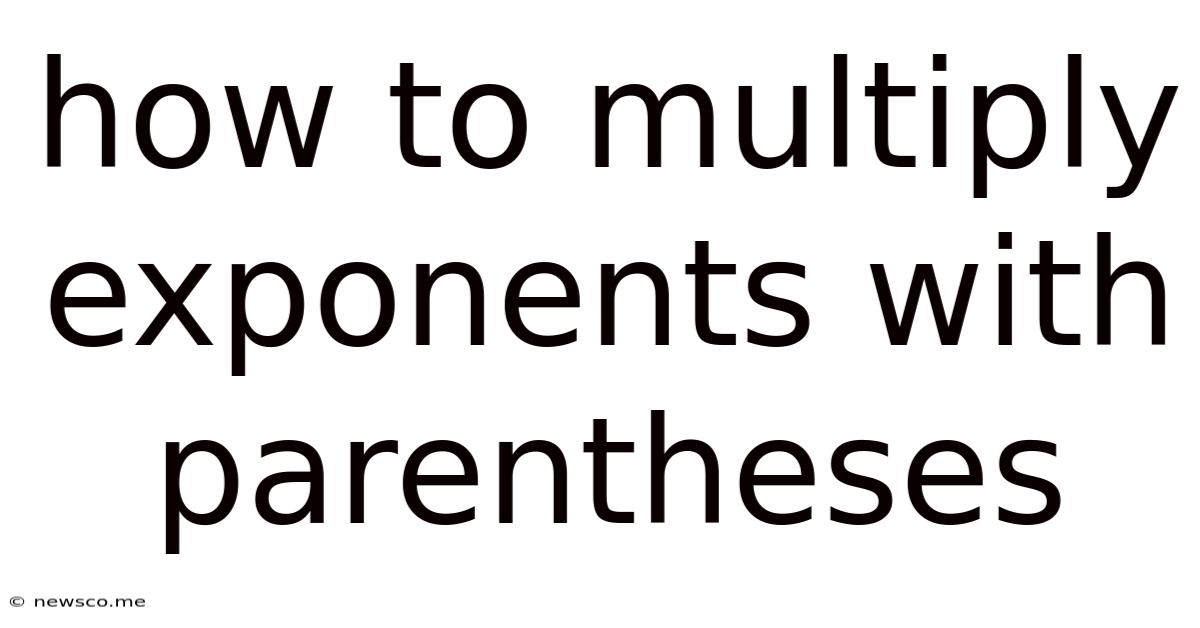How To Multiply Exponents With Parentheses
News Co
Apr 27, 2025 · 6 min read

Table of Contents
How to Multiply Exponents with Parentheses: A Comprehensive Guide
Understanding how to multiply exponents, especially when parentheses are involved, is fundamental to mastering algebra and higher-level mathematics. This comprehensive guide will break down the process step-by-step, covering various scenarios and providing ample examples to solidify your understanding. We'll explore the core rules, tackle common pitfalls, and offer strategies for tackling complex problems.
The Power Rule: The Foundation of Exponent Multiplication
The cornerstone of multiplying exponents with parentheses lies in understanding the power rule of exponents. This rule states that when raising a power to another power, you multiply the exponents. Mathematically, this is represented as:
(a<sup>m</sup>)<sup>n</sup> = a<sup>m*n</sup>
Where:
- a is the base (any real number, variable, or expression)
- m and n are the exponents (any real numbers)
Let's illustrate with some examples:
- (x<sup>2</sup>)<sup>3</sup> = x<sup>2*3</sup> = x<sup>6</sup> Here, the base is 'x', and the exponents are 2 and 3. We multiply the exponents to get the simplified result.
- (2<sup>3</sup>)<sup>4</sup> = 2<sup>3*4</sup> = 2<sup>12</sup> = 4096 This example shows the power rule applied to a numerical base. Remember to evaluate the final exponent if necessary.
- ((-3)<sup>2</sup>)<sup>5</sup> = (-3)<sup>2*5</sup> = (-3)<sup>10</sup> = 59049 This example highlights that the power rule applies even when the base is negative. Pay close attention to signs, especially with even and odd exponents.
Multiplying Exponents with Multiple Bases and Parentheses
Things get more interesting when you have multiple bases within parentheses. In this case, you apply the power rule to each base individually. Consider the following scenario:
(a<sup>m</sup>b<sup>n</sup>)<sup>p</sup> = a<sup>mp</sup>b<sup>np</sup>
Let's look at examples:
- (x<sup>2</sup>y<sup>3</sup>)<sup>4</sup> = x<sup>24</sup>y<sup>34</sup> = x<sup>8</sup>y<sup>12</sup> The power of 4 is applied to both 'x' and 'y'.
- (2x<sup>3</sup>)<sup>2</sup> = 2<sup>2</sup>x<sup>3*2</sup> = 4x<sup>6</sup> Notice that the coefficient '2' is also raised to the power of 2.
- (-3a<sup>4</sup>b<sup>-2</sup>)<sup>3</sup> = (-3)<sup>3</sup>a<sup>43</sup>b<sup>-23</sup> = -27a<sup>12</sup>b<sup>-6</sup> = -27a<sup>12</sup>/b<sup>6</sup> This example involves negative exponents, reminding us that a negative exponent means the reciprocal.
Dealing with Fractions and Negative Exponents within Parentheses
When fractions and negative exponents are part of the expression within parentheses, the same principles apply, but extra care is needed. Remember these key rules:
- (a/b)<sup>m</sup> = a<sup>m</sup>/b<sup>m</sup> The power is distributed to both the numerator and the denominator.
- a<sup>-m</sup> = 1/a<sup>m</sup> A negative exponent signifies a reciprocal.
Let's examine some examples:
- (x<sup>2</sup>/y<sup>3</sup>)<sup>4</sup> = x<sup>24</sup>/y<sup>34</sup> = x<sup>8</sup>/y<sup>12</sup> The power is applied to both 'x' and 'y'.
- (2x<sup>-3</sup>)<sup>2</sup> = 2<sup>2</sup>x<sup>-3*2</sup> = 4x<sup>-6</sup> = 4/x<sup>6</sup> Note the conversion of the negative exponent.
- ((-2/3)<sup>2</sup>)<sup>3</sup> = (-2/3)<sup>6</sup> = 64/729 Remember to carefully calculate the numerical result.
Combining Rules: Complex Scenarios
More complex problems might involve a combination of the rules discussed above. The key is to break down the problem into smaller, manageable steps. Let's tackle some more challenging examples:
Example 1: Simplify ( (2x<sup>3</sup>y<sup>-2</sup>)<sup>2</sup> (x<sup>-1</sup>y<sup>4</sup>)<sup>3</sup> )
-
First, apply the power rule to each parenthesis individually: (4x<sup>6</sup>y<sup>-4</sup>)(x<sup>-3</sup>y<sup>12</sup>)
-
Next, combine like bases by adding exponents: 4x<sup>6+(-3)</sup>y<sup>-4+12</sup> = 4x<sup>3</sup>y<sup>8</sup>
Example 2: Simplify ( (a<sup>2</sup>/b<sup>-1</sup>)<sup>3</sup> / (a<sup>-1</sup>b<sup>2</sup>)<sup>2</sup> )
-
Apply the power rule to the numerator and denominator separately: (a<sup>6</sup>/b<sup>-3</sup>) / (a<sup>-2</sup>b<sup>4</sup>)
-
Simplify the numerator: a<sup>6</sup>b<sup>3</sup>
-
Rewrite the expression as a multiplication of fractions: (a<sup>6</sup>b<sup>3</sup>) * (a<sup>2</sup>/b<sup>4</sup>)
-
Combine like bases: a<sup>8</sup>b<sup>-1</sup> = a<sup>8</sup>/b
Common Mistakes to Avoid
Several common mistakes can hinder your progress when multiplying exponents with parentheses. Let’s address some of them:
- Incorrectly distributing exponents: Remember to multiply, not add, exponents when applying the power rule. A frequent error is adding exponents instead of multiplying them.
- Forgetting to apply the power rule to coefficients: Coefficients within parentheses must also be raised to the given power.
- Misinterpreting negative exponents: Always remember that a negative exponent indicates the reciprocal, not a negative value.
- Incorrectly combining bases: Only combine terms with the same base by adding their exponents.
Practice Makes Perfect
Mastering exponent multiplication takes practice. Work through numerous examples, varying the complexity and types of bases and exponents. Start with simpler problems and gradually increase the difficulty. Online resources and textbooks offer a wealth of practice problems to hone your skills. Regular practice will build your confidence and ensure a solid grasp of this fundamental algebraic concept.
Advanced Applications
Understanding exponent multiplication with parentheses is crucial in many advanced mathematical concepts, including:
- Calculus: Derivatives and integrals often involve manipulating exponents.
- Linear Algebra: Matrix operations and vector calculations utilize exponent rules.
- Differential Equations: Solving differential equations frequently requires skillful exponent manipulation.
By mastering this fundamental skill, you build a strong foundation for success in more advanced mathematical fields.
Conclusion
Multiplying exponents with parentheses might initially appear daunting, but by systematically applying the power rule and carefully addressing potential pitfalls, you can confidently solve even the most complex problems. Remember to practice regularly, and break down complex problems into smaller, more manageable steps. With consistent effort, you'll develop a strong understanding of this essential mathematical concept. The rewards extend far beyond algebra, providing a solid foundation for future mathematical endeavors.
Latest Posts
Related Post
Thank you for visiting our website which covers about How To Multiply Exponents With Parentheses . We hope the information provided has been useful to you. Feel free to contact us if you have any questions or need further assistance. See you next time and don't miss to bookmark.